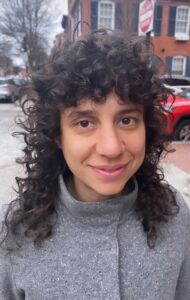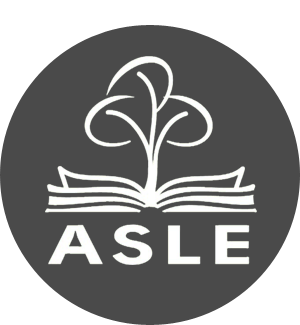ASLE’s Scholar of the Month for July 2023 is Marina Bedran.

Marina Bedran is Assistant Professor of Lusophone Literatures and Cultures at Johns Hopkins University. She works on Brazilian literature and visual culture from the nineteenth century to the present, emphasizing exchanges between Latin America and the Lusophone world. She is currently working on a book manuscript that discusses experimental media-based art and writing since the postwar period that, by turning to Amazonia, generated ways of thinking about the environment, development, and indigeneity that anticipate contemporary discourses around these topics. Her research and publications have also examined conceptualism and public memory and issues of class and race in feminist filmmaking from the Global South, and have appeared in journals such as ARTMargins, the Harvard Review of Latin America, and Letterature d’America. Her first book analyzes the correspondence between Robert Louis Stevenson and Henry James, which she translated into Portuguese, showing how it influenced the way both authors thought about the art and role of fiction, ultimately helping shape the debate about modern literature and the field of literary studies.
How did you become interested in studying ecocriticism and/or the environmental humanities?
It is difficult to pinpoint the origin of my interest in ecocriticism and the environmental humanities, but a few junctures come to mind. Before I was aware of such a field, I’d read with interest a line of scholarship in/on Brazil that investigates the ways in which nature has been represented, romanticized, or vilified in literature and art since colonial times and especially how it shaped the construction of Brazilian modernity. I think, for instance, of Brazilian literary critic Flora Sussekind’s perusal of travel narratives in O Brasil não é longe daqui: o narrador, a viagem (1990), Lilia Schwarcz’s work on French painter Nicolas-Antoine Taunay’s representation of the tropics (O sol do Brasil: Nicolas-Antoine Taunay e as desventuras dos artistas franceses na corte de d. João, 2008), or Argentina-born scholar Natalia Brizuela’s insightful discussion of photography and landscape (Fotografia e império: paisagens pata um Brasil moderno, 2012).
Then, in the early 2010s, while working at Instituto Moreira Salles in São Paulo, I started researching contemporary photography and encountered a spate of experimental work focused on Amazonia, which intrigued me, as I had never been fond of nature photography, a genre notorious for overusing clichés. Around that time, I first went to Belém do Pará in the Brazilian Amazon, a deeply transformative experience to me. It revealed the infinite complexity of nature and culture in Amazonia, and I became interested in seeing how art and literature make sense of it.
Another influential moment occurred in my early years of graduate school when I read Rob Nixon’s Slow Violence and the Environmentalism of the Poor. The book had a profound impact on me. To this day, its power remains evident whenever I assign it to my students, who instantly embrace its concepts and language to talk about a range of topics.
Who is your favorite environmental artist, writer, or filmmaker? Or what is your favorite environmental text? Why?
This is a hard question. But I can say that I enjoy reading or re-reading any text and thinking about them from an environmental perspective. I’ve been immersed in the poetry of Carlos Drummond de Andrade and João Cabral de Mello Neto for a new project, and there is so much there that expands definitions of the human and the non-human, matter and its agency. I also really enjoyed José Miguel Wisnik’s book on Drummond’s “geoliterature” and how mining in the state of Minas Gerais shaped the form and content of his poems.
A couple of years ago, I decided to rewatch Andrei Tarkovsky’s filmography and was mesmerized by his portrayal of the environment, natural or (post-)human. His films were, moreover, deeply entangled with and prescient of the environmental consequences of development and nuclear energy. By the way, contemporary cinema, seems to me a remarkable medium for exploring environmental issues from a sensory and immersive perspective. One example is the work of Argentine filmmaker Lucrecia Martel. Though not explicitly environmental, her films provoke contemplation on topics such as gender in light of posthumanism (Muta, 2011) or how the environment is traversed by the enduring effects of colonialism (Nueva Argirópolis, 2010; Zama, 2017). Another noteworthy and often unsettling contribution comes from Véréna Paravel and Lucien Castaing-Taylor at Harvard’s Sensory Ethnography Lab. One of my favorite documentaries is Leviathan (2012), an immersive experience of the fishing industry that takes viewers onboard a trawler. While the film considers the fishermen’s perspective, it also shifts the focus away from the human, venturing into the non-human world of the oceans, including the fish and the vessel itself.
Last but not least, Indigenous art and writings offer the most thought-provoking reflections on the environment. To name only two, Yanomami artist based in Venezuela Sherowanawe Hakihiiwe, whose careful observation and stylized presentation of nature bridge avant-garde art with indigenous cosmologies, and prominent indigenous leader and thinker Ailton Krenak, whose incredibly sharp ideas force us to reevaluate our notions of what constitutes the environment and our place within it.
What are you currently working on?
I am currently at work on a book titled A Turn to Amazonia: Developmentalism and the Aesthetics of Polyculture, which builds upon my Ph.D. dissertation. The book demonstrates that the roots of contemporary perceptions of Amazonia—as a site of natural and cultural diversity to be protected against extractivism and development—can be found in art, literature, and culture about Amazonia from the 1950s through the 1980s. It argues that these cultural forms crafted an aesthetics of polyculture that draws on but troubles the logic of developmentalism. Drawing on extensive archival work, interviews, and close readings of texts, multimedia art, film, and a range of other materials, the book unearths an experimental canon of work produced in Brazil, often overlooked by cultural scholarship on Amazonia, that played a key role in shaping public perceptions of the region. This body of work includes well-known Brazilian artists and intellectuals such as Flávio de Carvalho, Lygia Pape, Cildo Meireles, Mario Pedrosa, Darcy Ribeiro, Glauber Rocha, and Jorge Bodanzky, as well as Swiss-born photographer Claudia Andujar and African American photographer George Leary Love, who were based in Brazil when the state was developing the Amazon. During a period when many prominent intellectuals, artists, and writers embraced modernizing principles centered on urban and industrial imaginaries, often in ways that reproduced the Brazilian government’s rhetoric of political and economic progress and development, formal experimentation, I demonstrate, opened up new ways of thinking about Amazonia.
What is something you are reading right now (environmental humanities-related or otherwise) that inspires you, either personally or professionally? Comment briefly on why or how it inspires you.
I’ve been reading about infrared photography for a chapter of the book and finding it fascinating. The technique’s capacity to make the invisible visible has appealed to scientists, physicians, therapists, experimental artists, and mystics. It has found applications in various domains, such as psychedelic culture, space exploration, military tactics, and agricultural surveying. It has been purported to treat ailments, capture thoughts, and has been employed in both extractive practices and ecological pursuits. It is nice to find resonances between the humanities and the hard sciences and see where they diverge, taking advantage of the interdisciplinarity that the environmental humanities allow for, or better put, requires, from scholars. While today’s discussions of media and technology tend to acquire apocalyptic tones, media theory – think of the work of Yuk Hui or Jussi Parikka – is also a field that has taken seriously the aim to decenter the human, finding and proposing networks and swarms among humans, non-humans, and more-than-humans.
Is there a scholar in the field who inspires you? Why?
More than one! I already mentioned how Rob Nixon’s book Slow Violence had a huge impact on me. I find his writing in general inspiring: theoretically rigorous but always accessible, beautifully penned, and politically engaged. I also appreciate his experimentation with various genres (memoir and essay), media (photography and text), and topics (bridges and birds). Among the names that consistently captivate my attention is Amitav Ghosh. His novels and criticism are not only superb but unobvious.
It is truly inspiring to witness the expansion and diversification of the field as a whole. Conferences like ASLE (Association for the Study of Literature and Environment) provide a platform for scholars from different disciplines to explore transhistorical materials, diverse languages, and various media. Ecocriticism is also burgeoning in my own field of Lusophone and Latin American studies, and the work of exceptional scholars such as Mary Louise Pratt and Gisela Heffes has played an important role in this.
I feel fortunate to be surrounded by scholars doing innovative and inspired work at Johns Hopkins University, a hub for cutting-edge work in the environmental humanities. The work of Jane Bennett, Naveeda Kahn, and folks at the Ecological Design Lab is exceptional, and luckily there is so much collaboration and exchange.
